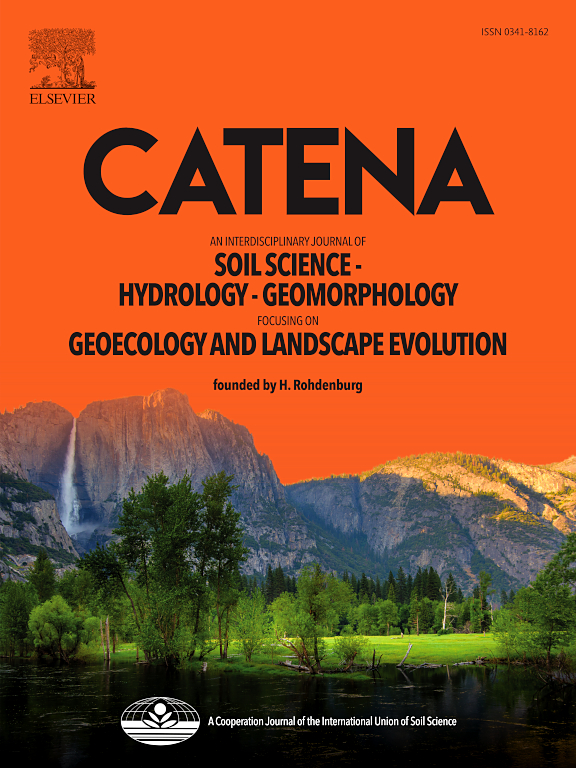Holocene landscape changes and human impact in Southern Italy: A case-study from the Mar Piccolo semi-enclosed marine basin (Taranto)
IF 5.4
1区 农林科学
Q1 GEOSCIENCES, MULTIDISCIPLINARY
引用次数: 0
Abstract
Coastal environments in the Mediterranean are currently facing significant challenges due to the impact of Global Warming, largely attributed to human activities. The Mar Piccolo stands out as one of the Mediterranean’s most polluted semi-enclosed marine basins. To delve into its environmental changes, a sediment core (S05B) and eight surface sediment samples underwent extensive analysis, encompassing sedimentological and palynological organic matter assessments. The main objective was to uncover the principal morpho-sedimentary processes from latest Pleistocene to Holocene, resulting in the identification of five distinct landscape scenarios. Initially, during a period of arid climate, the area transitioned from fluvial incision to the formation of brackish ponds. As the Holocene brought about improved climatic conditions, the Mar Piccolo underwent further transformations, changing into a paralic environment where freshwater and salt marshes coexisted. The saltmarshes were sustained by sporadic marine spillovers, as indicated by foraminiferal organic linings. At 10.3 cal ka BP, a marine ingression took place marked by dinocysts, aligning with the Mediterranean sea level curve. This led to the establishment of a low hydrodynamic semi-enclosed marine basin, although changes in bottom oxygenation occurred over time. Anoxic events were identified during the Sapropel 1 deposition and the 4.2 ka BP megadrought event. After the 4.2 ka BP event, evidence of human impact emerges as indicated by the occurrence of human intestinal parasites resting eggs along with a shift in phytoclasts assemblages towards a dominance of cuticles suggesting intensified agricultural activities around the basin. Furthermore, analyses of palynological organic matter in surface sediments provide evidence of significant impacts from current human activities. Consequently, evaluating both past and ongoing anthropogenic influences through palynological organic matter analysis represents a crucial application in this research area.
意大利南部全新世景观变化与人类活动影响——以塔兰托Mar Piccolo半封闭海相盆地为例
由于全球变暖的影响,地中海沿岸环境目前面临着重大挑战,而全球变暖主要归因于人类活动。Mar Piccolo是地中海污染最严重的半封闭海洋盆地之一。为了深入研究其环境变化,对沉积物岩心(S05B)和8个地表沉积物样本进行了广泛的分析,包括沉积学和孢粉学有机质评估。主要目的是揭示从最新更新世到全新世的主要形态-沉积过程,从而确定五种不同的景观情景。最初,在一段干旱气候期间,该地区从河流切口过渡到微咸池塘的形成。随着全新世气候条件的改善,Mar Piccolo经历了进一步的转变,变成了淡水和盐沼共存的海陆环境。有孔虫有机衬里表明,盐沼是由零星的海洋溢出物维持的。在10.3 cal ka BP,与地中海海平面曲线一致,发生了以恐龙囊为标志的海侵。这导致了低水动力半封闭海相盆地的建立,尽管随着时间的推移,底部氧合发生了变化。在Sapropel 1沉积和4.2 ka BP特大干旱事件中发现了缺氧事件。在4.2 ka BP事件之后,人类影响的证据出现,如人类肠道寄生虫休眠卵的出现以及植物碎屑组合向角质层为主的转变,表明盆地周围农业活动加剧。此外,对地表沉积物中孢粉有机质的分析提供了当前人类活动显著影响的证据。因此,通过孢粉有机质分析来评估过去和现在的人为影响是这一研究领域的重要应用。
本文章由计算机程序翻译,如有差异,请以英文原文为准。
求助全文
约1分钟内获得全文
求助全文
来源期刊

Catena
环境科学-地球科学综合
CiteScore
10.50
自引率
9.70%
发文量
816
审稿时长
54 days
期刊介绍:
Catena publishes papers describing original field and laboratory investigations and reviews on geoecology and landscape evolution with emphasis on interdisciplinary aspects of soil science, hydrology and geomorphology. It aims to disseminate new knowledge and foster better understanding of the physical environment, of evolutionary sequences that have resulted in past and current landscapes, and of the natural processes that are likely to determine the fate of our terrestrial environment.
Papers within any one of the above topics are welcome provided they are of sufficiently wide interest and relevance.
 求助内容:
求助内容: 应助结果提醒方式:
应助结果提醒方式:


